This guide initially displays common tracks of all shapes. Use the selectors below to view particular shapes, include rare species, or search by name.
Anything that moves over the ground leaves some sort of marking of its passage. In particular, footprints left behind in soil, snow, mud, or other ground surfaces provide a means of recognizing different species. The illustrations and characteristics listed below highlight key features that can be used to identify the tracks of many of the animals in the area.
Track References
Alderness Wilderness College
Animal Track ID [PDF]
Beartracker
Deerdance
Elbroch, Mark, 2003 Mammal Tracks and Signs: A Guide to North American Species
eNature
Gaits
Lowery, James, 2013 Tracker’s Field Guide. Falcon Guides
Nature Tracking
North Woods Guides
Outdoor Action
Subject Area Experts (all guides)
Steve Cary (butterflies)
Beth Cortright (insects)
Terry Foxx (invasive plants)
Leslie Hansen (mammals)
Richard Hansen (fish, mammals)
Dorothy Hoard (butterflies, trees)
Chick Keller (flowers, herbarium)
Shari Kelley (geology)
Kirt Kempter (geology)
Garth Tietjen (reptiles)
David Yeamans (birds)
Web Development and Content Management
Pat Bacha
Jennifer Macke
Graham Mark
Akkana Peck
Contact
Please contact us for local nature questions and sightings. We welcome comments, corrections, and additions to our guides.
For more information about local nature, please visit our Nature Blog or subscribe to PEEC This Week.
Make Selection
 Drawn based upon Beartracker image 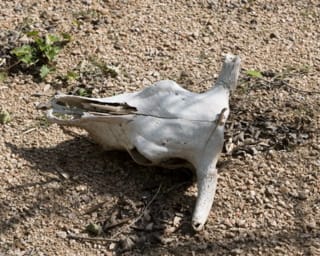 Photo: Carol M. Highsmith 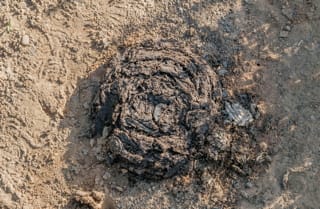 Photo: Wilfredor |  Cow(Bos taurus)Family: Bovidae (Hollow-horned Ruminants) Gait: walk Form: dew claws; hoofed toes Front Foot: 2 toes; 2.6 in (6.6 cm) - 4.6 in (11.7 cm) Hind Foot: 2 toes; 2.4 in (6.1 cm) - 4.7 in (11.9 cm) Hind feet are wider and larger than the front feet. The hind tracks land nearly on top of the front. Two dew claws only register in deep snow or mud. Cow scat is large, flat and roundish. Often called "patties", "pies", or "chips" from the shape. |
 Drawn based upon National Park Service image 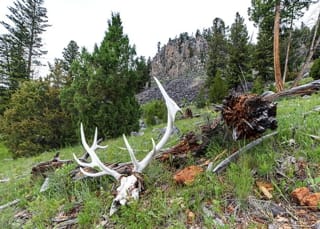 Photo: Jacob W. Frank 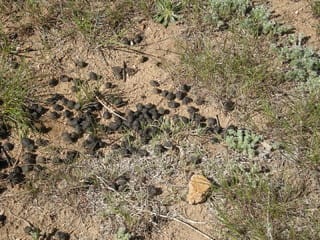 Photo: redazadi |  Elk, Wapiti(Cervus elaphus canadensis, Cervus canadensis)Family: Cervidae (Ruminants) Gait: gallop, lope, trot, walk Form: dew claws; hoofed toes Front Foot: 2 toes; 2.9 in (7.4 cm) - 4.7 in (11.9 cm) Hind Foot: 2 toes; 2.0 in (5.1 cm) - 4.6 in (11.7 cm) The toes are blunt with a straight or slightly convex outer surface. The cleave area between the toes may appear raised. Elk scat consists of a pile of roundish pellets that can be slightly squashed and misshapen. Mammal Guide - Elk |
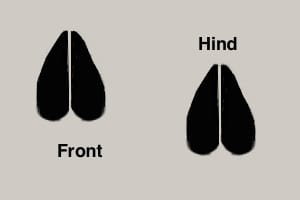 Drawn based upon National Park Service image 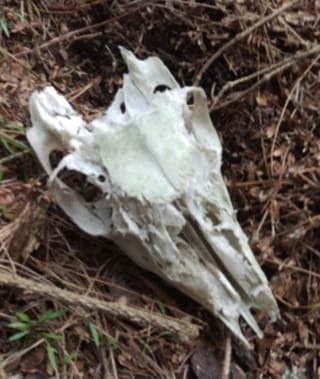 Photo: ktinsman 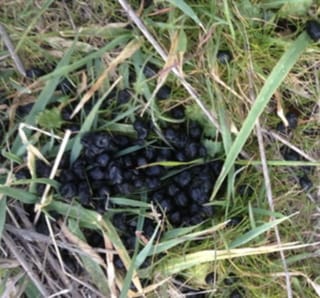 Photo: Nick Trow |  Mule Deer(Odocoileus hemionus)Family: Cervidae (Ruminants) Gait: gallop, lope, pronk, trot, walk Form: dew claws; hoofed toes Front Foot: 2 toes; 2.0 in (5.1 cm) - 3.2 in (8.1 cm) Hind Foot: 2 toes; 1.5 in (3.8 cm) - 3.0 in (7.6 cm) Overall the track forms a heart-shape with pointed toes. The front track is slightly larger than the back. Scat commonly consists of dimpled pellets in small piles. However, it can be a solid clump. Mammal Guide - Mule Deer |
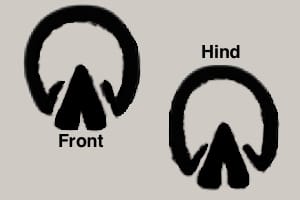 Drawn based upon Alex Brollo image 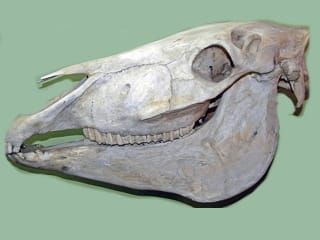 Photo: James St. Johm 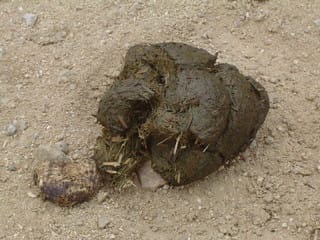 Photo: Horrortaxi |  Horse(Equus ferus caballus)Family: Equidae (Horses) Gait: gallop, lope, trot, walk Form: no claws; hoofed toes Front Foot: 2 toes; 4.9 in (12.4 cm) - 5.5 in (14.0 cm) Hind Foot: 2 toes; 4.6 in (11.7 cm) - 5.4 in (13.7 cm) The horse has one rounded toe on each foot. The front track appears rounder than the back which is more oval in shape. Horse scat typically consists of a large pile of small balls. Herbaceous matter can often be seen. |
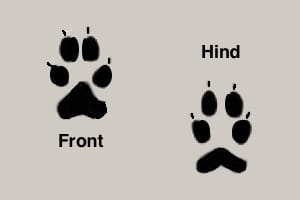 Drawn based upon US Geological Service image 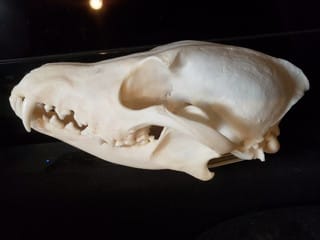 Photo: agirlnamednee 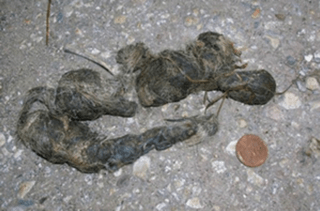 Photo: California Department of Fish and Wildlife |  Coyote(Canis latrans)Family: Canidae (Canines) Gait: gallop, lope, overstep walk, trot Form: small claws; round toes Front Foot: 5 toes; 1.8 in (4.6 cm) - 3.0 in (7.6 cm) Hind Foot: 4 toes; 1.7 in (4.3 cm) - 3.0 in (7.6 cm) The fifth toe on the front foot does not usually register. The negative space between the toes forms an "X" shape. Coyote scat contains a variety of different substances including meat and hair. The shape is generally tubular and usually twisted at least one end. Mammal Guide - Coyote |
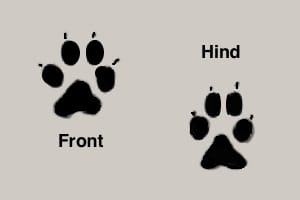 Drawn based upon US Geological Service image  Photo: Katie Collins 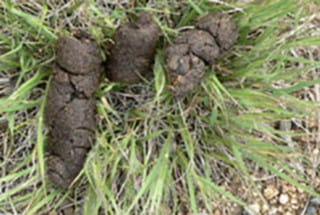 Photo: California Department of Fish and Wildlife |  Dog, Domestic Dog(Canis lupus familiaris)Family: Canidae (Canines) Gait: overstep walk, trot Form: large claws; round toes Front Foot: 5 toes; 1.0 in (2.5 cm) - 6.0 in (15.2 cm) Hind Foot: 4 toes; 0.9 in (2.3 cm) - 6.0 in (15.2 cm) The first toe on the front foot usually does not register. Toe prints for dogs typically are more splayed out than for the wild canines. Dog usually consists of twisted ropes with tapered ends and a smooth surface. |
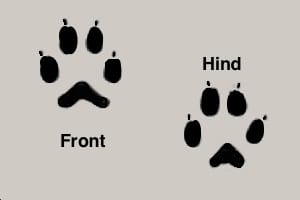 Drawn based upon US Geological Service image 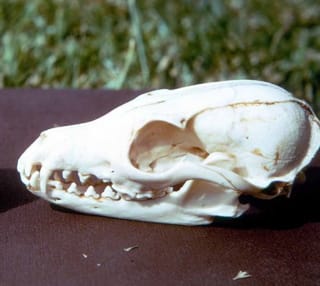 Photo: California Department of Fish and Wildlife  Photo: albedo20 |  Fox(Urocyon cinereoargenteus)Family: Canidae (Canines) Gait: gallop, lope, trot, understep walk Form: semi-retractable claws; round toes Front Foot: 5 toes; 1.3 in (3.3 cm) - 2.1 in (5.3 cm) Hind Foot: 4 toes; 1.2 in (3.0 cm) - 1.8 in (4.6 cm) The first toe on the front paw is further up the leg and usually does not register. The track is broader than other canines and often does not have the typical "X" shape. Scat tends to take the shape of twisted cords. However, given the variety in diet of the fox, the shape and color can vary considerably. Mammal Guide - Gray Fox |
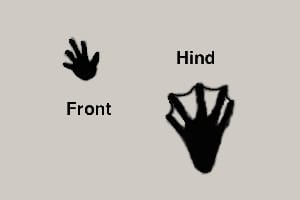 Drawn based upon Beartracker image 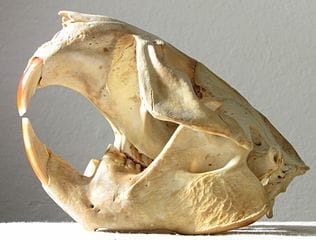 Photo: William N. Norton 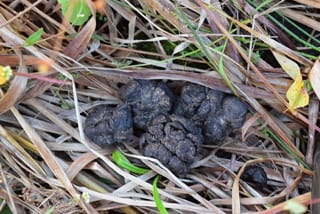 Photo: NC Wetlands |  Beaver(Castor canadensis)Family: Castoridae (Beavers) Gait: bound, walk Form: small claws; long toes Front Foot: 5 toes; 1.7 in (4.3 cm) - 3.5 in (8.9 cm) Hind Foot: 5 toes; 4.1 in (10.4 cm) - 7.9 in (20.1 cm) The hind foot has very long webbed toes; the inner toes do not always register. The track may appear bird-like. Beaver scat is primarily made up of clumps of woody material. It is often deposited directly in water, washing up on shore. Mammal Guide - Beaver |
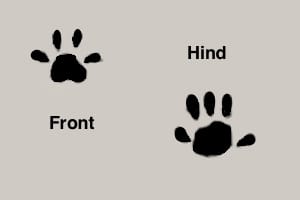 Drawn based upon Beartracker image 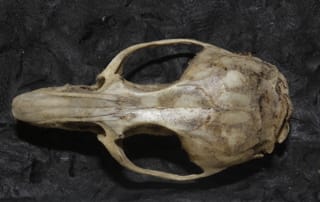 Photo: Juan Cruzado Cortes 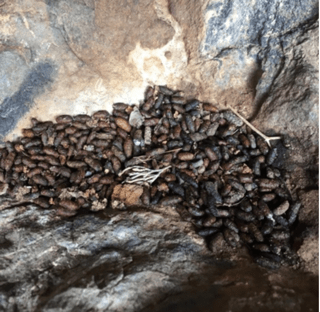 Photo: William Terry Hunefeld |  Woodrat(Neotoma spp.)Family: Cricetidae (New World Rats and Mice, Voles, Hamsters, and Relatives) Gait: bound Form: small claws; round toes Front Foot: 5 toes; 4.0 in (10.2 cm) - 0.7 in (1.7 cm) Hind Foot: 5 toes; 0.6 in (1.5 cm) - 0.9 in (2.3 cm) Front and back prints may overlap giving the impression of alternating single prints. Scat consists of a pile of fecal pellets that can vary in color and texture. Woodrats build a "house" of sticks with their nest inside. There is usually a well-worn track going back and forth from the house. Mammalian Guide - Woodrat |
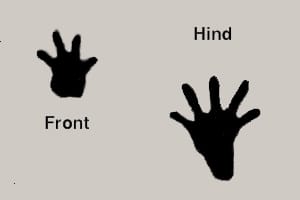 Drawn based upon US Geological Society image 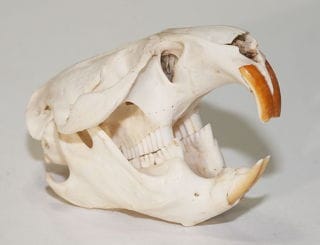 Photo: Camazine 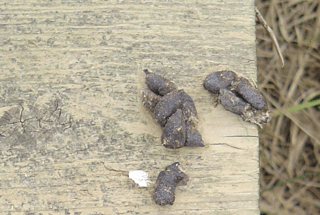 Photo: born1945 |  Muskrat(Ondatra zibethicus, Castor zibethicus)Family: Cricetidae (New World Rats and Mice, Voles, Hamsters, and Relatives) Gait: lope, walk Form: small claws; long toes Front Foot: 5 toes; 1.5 in (3.8 cm) - 2.5 in (6.4 cm) Hind Foot: 5 toes; 3.0 in (7.6 cm) - 5.0 in (12.7 cm) Small fifth toe nubbin on front foot can only be seen in very clear tracks. Hind paws are much wider than long. Scat is oval and often deposited on exposed logs at water's edge in a sticky mass. Dens are made of reeds and appear as small conical domes. Mammal Guide - Muskrat |
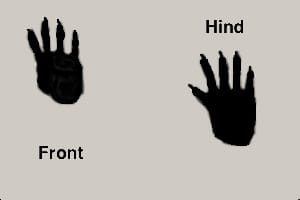 Drawn based upon US Geological Society image  Photo: Jeff Camilleri  Photo: akruger90 |  Porcupine(Erethizon dorsatum)Family: Erethizontinae (New World Porcupines) Gait: walk Form: small claws; round toes Front Foot: 4 toes; 1.0 in (2.5 cm) - 2.1 in (5.3 cm) Hind Foot: 5 toes; 1.4 in (3.6 cm) - 3.0 in (7.6 cm) The soles of feet have small nubs giving prints a rough texture. Toes often do not register. Winter scat is red from conifers; summer scat is brown to black from a diet that includes more herbs and scrubs. Either form may be composed of individual pellets or strings of pellets joined by fibers. Another sign of porcupine activity is bark chewed off of trees. Mammal Guide -Porcupine |
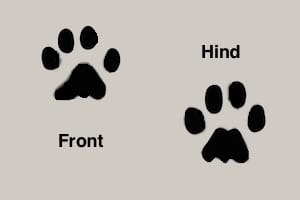 Drawn based upon US Geological Service image 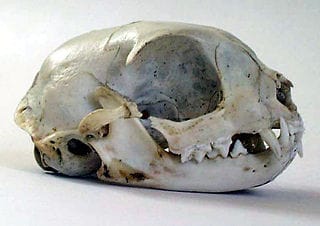 Photo: Tim Vickers 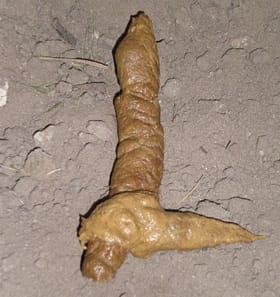 Photo: BrokenSphere |  Cat, House Cat(Felis catus)Family: Felidae (Cats) Gait: gallop, lope, overstep walk, trot Form: retractable claws; round toes Front Foot: 5 toes; 1.0 in (2.5 cm) - 1.6 in (4.1 cm) Hind Foot: 4 toes; 1.2 in (3.0 cm) - 1.6 in (4.1 cm) The front paw has a toe that usually does not register as it is higher up on the leg. Tracks are flat with toes and palm registering at the same depth. Claws rarely show. Cats usually cover their scat with dirt. In addition, they will often mark areas by spraying urine and/or rubbing cheek glands against objects. |
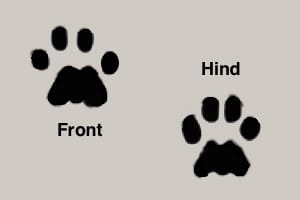 Drawn based upon US Geological Service image 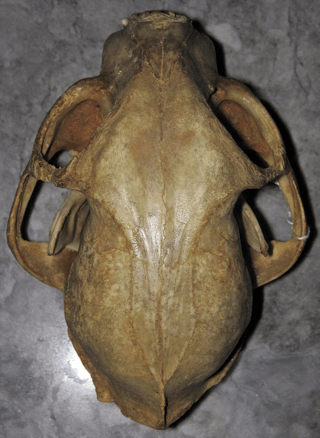 Photo: James St. John 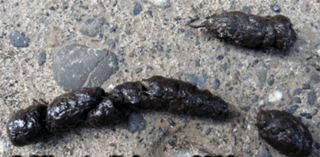 Photo: Kim A. Cabrera |  Bobcat(Lynx rufus, Felis rufus)Family: Felidae (Cats) Gait: gallop, lope, overstep walk, trot Form: retractable claws; round toes Front Foot: 5 toes; 1.5 in (3.8 cm) - 1.8 in (4.6 cm) Hind Foot: 4 toes; 1.5 in (3.8 cm) - 1.8 in (4.6 cm) One toe on the front paw usually does not register as it is higher up on the leg. Overall the track is flat with the toes and pads registering at the same depth. Bobcat scat looks like short pieces of segments cords with blunt end and very little twisting. The feces are very dense and often have a gray coating. Mammal Guide - Bobcat |
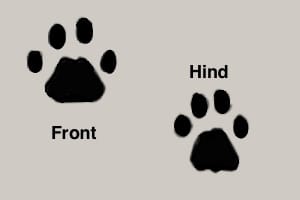 Drawn based upon National Park Service image 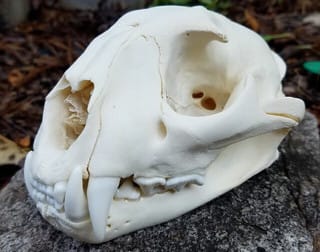 Photo: Katie Collins 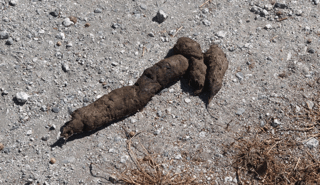 Photo: J. Maughn |  Mountain Lion, Cougar(Puma concolor)Family: Felidae (Cats) Gait: gallop, lope, overstep walk, trot Form: retractable claws; round toes Front Foot: 5 toes; 3.3 in (8.3 cm) - 4.0 in (10.2 cm) Hind Foot: 4 toes; 2.8 in (7.0 cm) - 4.0 in (10.2 cm) The front leg has a toe that is high up and does not register. The toes and paws all register to the same depth. Scat is large mount and volume. It varies in shape from irregular cylinders to pellets and frequently contains traces of hair or bone. Males urinate on loosely piled debris to mark their territory. Mammal Guide - Mountain Lion |
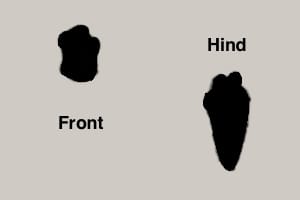 Drawn based upon US Geological Society image 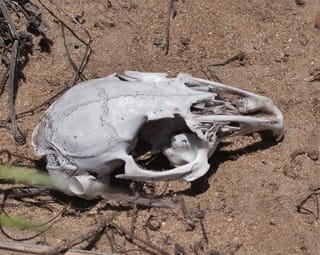 Photo: J. Maughn  Photo: Kim A. Cabrera |  Rabbit(Sylvilagus spp.)Family: Leporidae (Hares and Rabbits) Gait: bound Form: small claws; round toes Front Foot: 5 toes; 0.7 in (1.8 cm) - 2.0 in (5.1 cm) Hind Foot: 4 toes; 0.8 in (2.0 cm) - 2.8 in (7.1 cm) The fifth toe on the front foot is small and may not register. The back foot may appear symmetrical at times. The palm is covered with hair and may not register clearly. Cottontail scat is deposited singly and has a slightly squashed spherical appearance. A group of scat indicates that an animal spend some time in one spot. Mammal Guide - Rabbit |
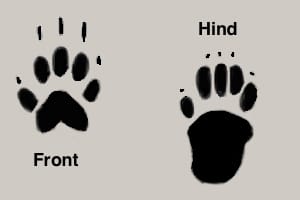 Drawn based upon US Geological Society image 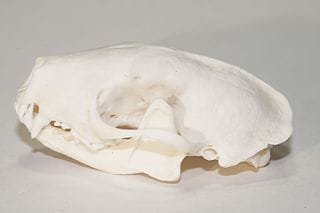 Photo: Scott Camazine 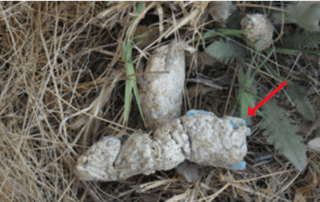 Photo: Kim Cabrera |  Skunk(Mephitis mephitis)Family: Mephitidae (Skunks) Gait: lope, overstep walk Form: large claws; round toes Front Foot: 5 toes; 1.0 in (2.5 cm) - 1.8 in (4.4 cm) Hind Foot: 5 toes; 1.3 in (3.2 cm) - 2.0 in (5.1 cm) The small toe on the inside of the hind foot does not always register. The interdigital and proximal pads as well as the heel pad can often be seen in a print. Scat is cylindrical with blunt ends. It is mostly composed of insect parts. Nests and burrows carry the smell of skunk musk. Mammal Guide - Skunk |
 Drawn based upon US Geological Survey image 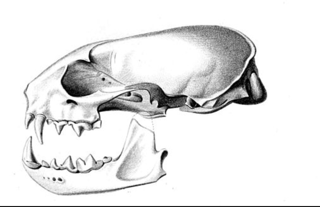 Photo: Alcide Dessalines d'Orbigny 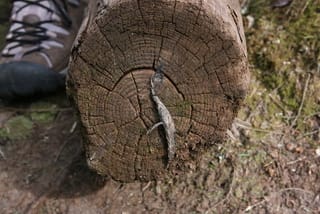 Photo: Connecticutbirder |  Weasel(Mustela spp.)Family: Mustelidae (Weasels, Badgers, and Otters) Gait: bound, lope, walk Form: small claws; round toes Front Foot: 5 toes; 0.7 in (1.8 cm) - 1.3 in (3.3 cm) Hind Foot: 5 toes; 0.6 in (1.5 cm) - 1.2 in (3.0 cm) The inside toe is smallest and registers lower than the other toes. Stride varies as weasels run and bound. The weasels stride varies since it often runs and leaps. Weasel scat is dark brown or black. It is long, thin and segmented, often having one end tapered. Weasels often cache dead mice and voles in a burrow or under a log. Mammal Guide - Weasel |
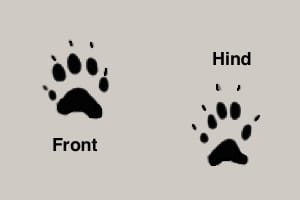 Drawn based upon National Park Service image 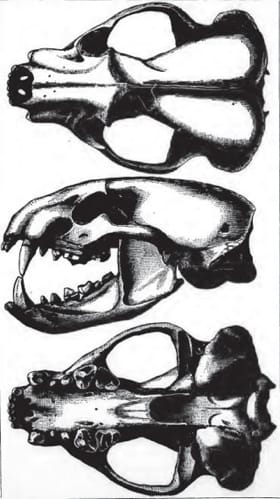 Photo: Elliot Coues 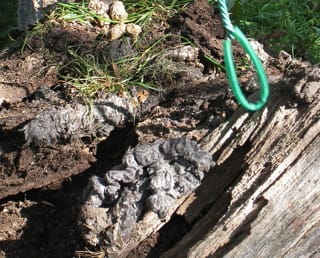 Photo: Frederique Lavoipierre |  Badger(Taxidea taxus)Family: Mustelidae (Weasels, Badgers, and Otters) Gait: gallop, lope, trot, walk Form: large claws; round toes Front Foot: 5 toes; 1.8 in (4.6 cm) - 2.7 in (6.9 cm) Hind Foot: 5 toes; 1.5 in (3.8 cm) - 2.7 in (6.9 cm) The first toe on all four feet is the smallest and often cannot be seen in a track. The front track is pigeon-toed. Badger scat typically looks like a twisted rope with tapered ends but varies considerably with diet. Burrows usually have a large round entrance with a mound of dirt to one side. Mammal Guide - Badger |
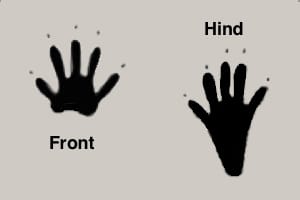 Drawn based upon US Geological Survey image  Photo: born1945 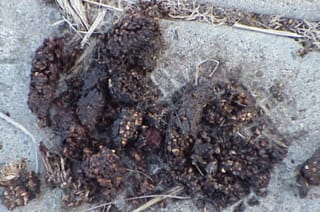 Photo: Kim A. Cabrera |  Raccoon(Procyon lotor)Family: Procyonidae (Raccoons, Ringtails, and Coatis) Gait: cross-over walk, gallop, lope Form: small claws; long toes Front Foot: 5 toes; 1.5 in (3.8 cm) - 3.2 in (8.1 cm) Hind Foot: 5 toes; 1.4 in (3.6 cm) - 4.1 in (10.4 cm) The inside toe registers slightly longer than the others. The negative space at the back of the front palm pad forms a small mound. Raccoon scat is tubular with an even thickness throughout and with blunt ends. Mammal Guide - Racoon |
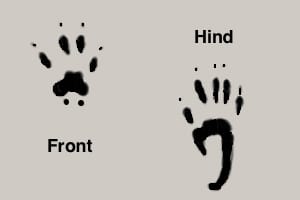 Drawn based upon US Geological Society image 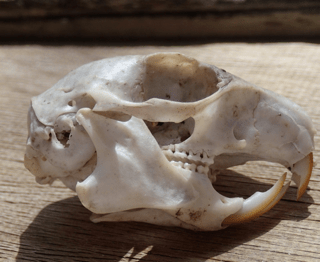 Photo: Robbie Spoule 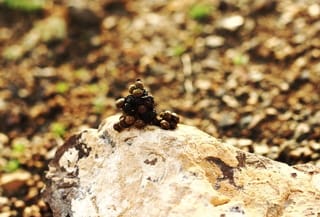 Photo: Thomas Vandenverghe |  Squirrel, Ground Squirrel, and Chipmunk(Sciurus, Callospermophilus, Tamias, Otospermophilu)Family: Sciuridae (Squirrels, Chipmunks, Marmots, and Prairie Dogs) Gait: bound Form: small claws; long toes Front Foot: 5 toes; 1.0 in (2.5 cm) - 1.9 in (4.8 cm) Hind Foot: 5 toes; 1.2 in (3.0 cm) - 2.1 in (5.3 cm) The inside toe on the front foot is very small and only registers as a small dot near the heel pad. The inner toes point forward; the outer toes point to the side. Scat varies from small, shapeless black masses to groups of small, unconnected oval pellets. Tree squirrels use large nests located high in the pines. Their presence is often given away by their call. Ground Squirrels and Chipmunks dig burrows. Mammal Guide - Squirrel Mammal Guide - Ground Squirrel Mammal Guide - Chipmunk |
 Drawn based upon US Geological Society image 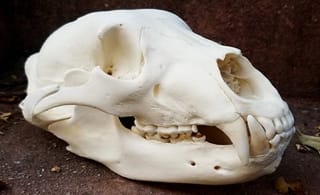 Photo: Katie Collins 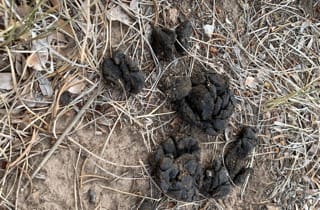 Photo: Jennifer Macke |  Black Bear(Ursus americanus)Family: Uridsae (Bears) Gait: gallop, overstep walk Form: large claws; round toes Front Foot: 5 toes; 2.1 in (5.3 cm) - 5.3 in (13.5 cm) Hind Foot: 5 toes; 2.8 in (7.1 cm) - 8.0 in (20.3 cm) The heel pads on both the front and hind paws may or may not register. The marks from the inside toes often register deeper than the others. Black bear scat is typically a pile of amorphous matter. Due to the variety of a bear's diet, it can appear as a thick cord with blunt ends. Mammal Guide - Bear |
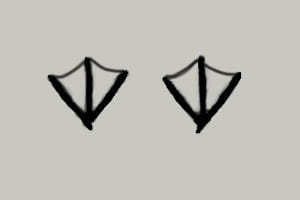 Drawn based upon Beartracker image  Photo: Giles Watson 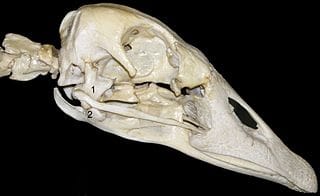 Photo: Uwe Gille |  Duck and Goose(Anas, Branta, Bucephala, Mergus spp.)Family: Anatidae (Ducks and Geese) Gait: waddle Form: small claws; long toes Foot: 3 toes; 1.5 in (3.8 cm) - 4.0 in (10.2 cm) The webbing on the feet is usually visible in the track. The size of the track varies by species. Droppings are tubular in shape, often over 3 in (7.6 cm) long and greenish when fresh. Bird Guide - Duck and Goose |
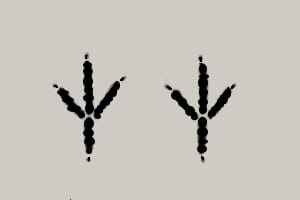 Drawn based upon Beartracker image 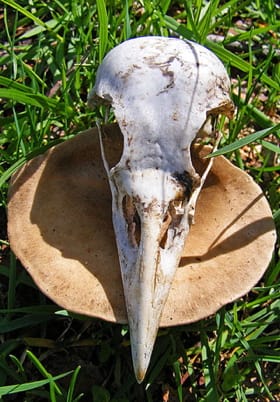 Photo: Plismo 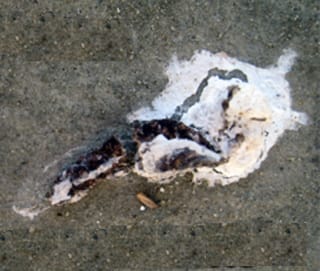 Photo: Kim A. Cabrera |  Crow and Raven(Corvus spp.)Family: Corvidae (Jays, Magpies, and Crows) Gait: hop, walk Form: large claws; long toes Foot: 4 toes; 1.7 in (4.3 cm) - 2.5 in (6.4 cm) Three toes point forward. The fourth toe that is as long as the others points backwards. The metatarsal pad is present but does not always register. Scat is a brown and white semiliquid mass with food remains. Large cough pellets can also be found containing seeds, nuts, insect parts, etc. Bird Guide - Crow and Raven |
 Drawn based upon US Geological Society image 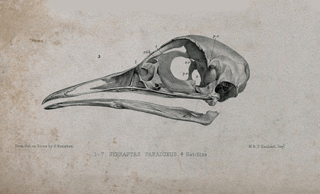 Photo: J. Erxleben 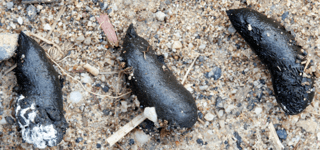 Photo: Kim A. Cabrera |  Grouse and Quail(Dendragapus spp., Callipepla spp.)Family: Phasianidae, Odeontophori (Grouse, Quail, and Allies) Gait: walk Form: small claws; long toes Foot: 4 toes; 1.4 in (3.6 cm) - 2.0 in (5.1 cm) The toe pointing backward is relatively short and may not register. The toes are wide and the claws can appear as attached. Grouse tracks are more distinctive than quail, appearing bumpier due to a fringe of scales. Scat consists of light to dark brown pellets, often with a white nitrogenous covering. Bird Guide - Grouse and Quail |
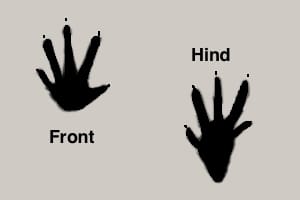 Drawn based upon Beartracker image 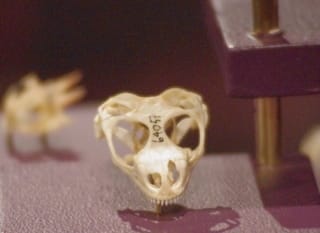 Photo: Joker Venom 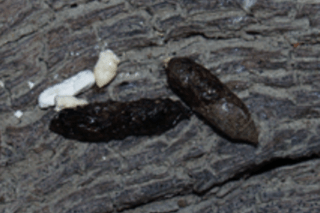 Photo: Kim A. Cabrera |  Lizard(Urosaurus, Crotaphylus, Phrynosoma spp.)Family: Phrynosomatidae, Crotaphy (North American Spiny Lizards, Leopard Lizards) Gait: trot, walk Form: small claws; long toes Front Foot: 5 toes; 0.6 in (1.5 cm) - 0.8 in (2.0 cm) Hind Foot: 5 toes; 0.6 in (1.5 cm) - 1.0 in (2.5 cm) Toes are very long and slender. Their length will vary by species. Scat consists of brown pellets several times longs than wide. White nitrogenous material may be found on one end. Reptile and Amphibian Guide - Lizard |
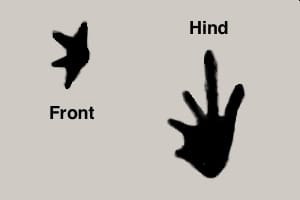 Drawn based upon Beartracker image  Photo: David J. Stang 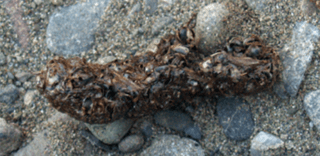 Photo: Kim A. Cabrera |  Frog, TreeFrog, and Toad(Rana, Hyla, Pseudacris, Bufo, Sepa spp.)Family: Ranidae, Bufonidae, Scaph (True Frogs and Treefrogs, Toads, Spadefoot Toads) Gait: bound, hop Form: no claws; long toes Front Foot: 4 toes; 0.5 in (1.3 cm) - 1.3 in (3.3 cm) Hind Foot: 5 toes; 0.8 in (2.0 cm) - 1.5 in (3.8 cm) Front feet face in. All of the hind toes but one face in. Aquatic frogs have webbing on the hind feet that extends almost all the way to the tip of the toes. Treefrogs have distinctive disc-shaped toes on all four feet which are used to aid in climbing. Toads are like aquatic frogs without the webbing. Scat is brown to black and tapered on the ends and much longer than wide. Reptile and Amphibian Guide - Aquatic Frog Reptile and Amphibian Guide - Treefrog Reptile and Amphibian Guide - Toad |
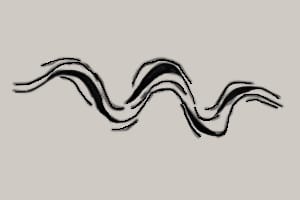 Drawn based upon Alderleaf Wilderness College image 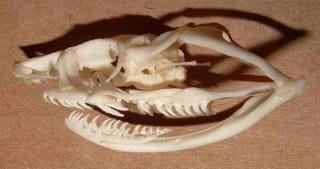 Photo: nonvenomous by Mokele 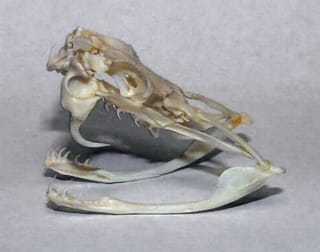 Photo: venomous by Mokele |  Snake(various species)Family: Colubridae, Viperidae (Advanced Snakes, Rattlesnakes and Other Vipers) Feet: none There are several different types of snake locomotion with the most common (side-to-side undulations) illustrated in the drawing. Other common types include concertina and slide-pushing. In all cases, the distance from one curve to the next varies greatly with size and species. Scat usually consists of a black to brown cord with pinched areas. Often white nitrogenous material is attached. Shed snake skin can often be found. Reptile and Amphibian Guide - Snake |
